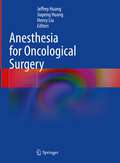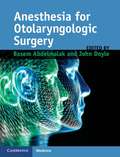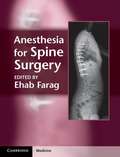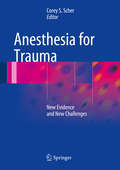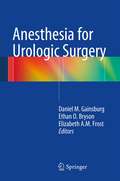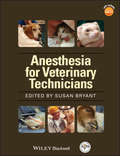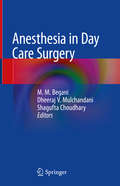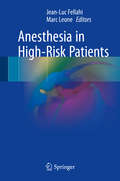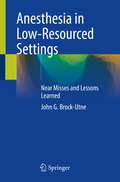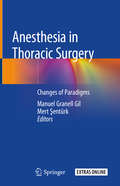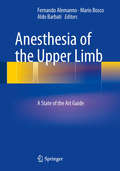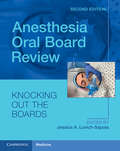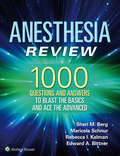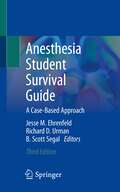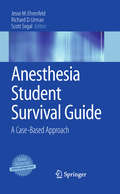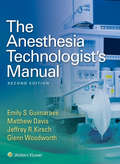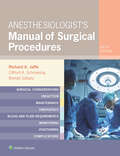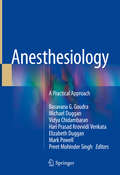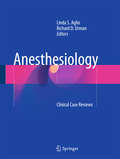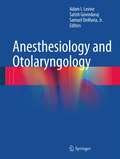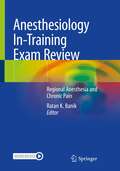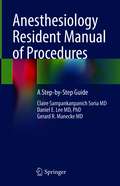- Table View
- List View
Anesthesia for Oncological Surgery
by Jeffrey Huang Jiapeng Huang Henry LiuThis book fills the need for a single comprehensive work on oncological anesthesia written by anesthesiologists. Divided into 14 distinct sections, this title includes the most up-to-date surgical oncologic procedures/treatments (new adjunctive treatments, new surgical techniques), perioperative care and anesthetic considerations and protocols. The highly experienced authors explain how the new treatments affect anesthesia implementations. Chapters are formatted to be “Comprehensive and Concise”, COMPREHENSIVE means the book will cover almost everything related to the anesthetic management of oncological surgical procedures and treatment, CONCISE means each chapter will be practical in format to include surgical highlights, positions, paralysis, anesthesia options, monitoring, durations, anesthesia key points, postoperative analgesia, and postoperative destinations”. An invaluable resource for anesthesiologists, certified registered nurse anesthetists (CRNA), certified Anesthesiologist assistants (CAA), anesthesia trainees (anesthesiology residents/fellows, students registered nurse anesthetists, student Anesthesiologist assistants), and oncological surgeons.
Anesthesia for Otolaryngologic Surgery
by Basem Abdelmalak John DoyleAnesthesia for Otolaryngologic Surgery offers a comprehensive synopsis of the anesthetic management options for otolaryngologic and bronchoscopic procedures. Authored by world authorities in the fields of anesthesiology and otolaryngology, both theoretical concepts and practical issues are addressed in detail, providing literature-based evidence wherever available and offering expert clinical opinion where rigorous scientific evidence is lacking. A full chapter is dedicated to every common surgical ENT procedure, as well as less common procedures such as face transplantation. Clinical chapters are enriched with case descriptions, making the text applicable to everyday practice. Chapters are also enhanced by numerous illustrations and recommended anesthetic management plans, as well as hints and tips that draw on the authors' extensive experience. Comprehensively reviewing the whole field, Anesthesia for Otolaryngologic Surgery is an invaluable resource for every clinician involved in the care of ENT surgical patients, including anesthesiologists, otolaryngologists and pulmonologists.
Anesthesia for Spine Surgery
by Ehab FaragThe increased complexity of spinal surgical procedures in recent years has required more sophisticated anesthetic management of patients undergoing these procedures. Spine surgery anesthesia is now recognized as a distinct sub-specialty, increasingly undertaken by general anesthesiologists as well as neuroanesthesiologists. Anesthesia for Spine Surgery describes the anesthetic management and surgical procedures at every vertebral level in both adult and pediatric patients. The most important related considerations are covered, including: * Postoperative pain management * One lung ventilation during anterior thoracic spine surgery * Intraoperative neuromonitoring * Fluid management Additional chapters review the radiological features of normal and abnormal spines, common complications of spine surgery and ASA closed claims relating to spine surgery anesthesia. Written by highly experienced neuroanesthesiologists and spine surgeons, Anesthesia for Spine Surgery is essential reading for trainee and practising anesthesiologists, neuroanesthesiologists and spine surgeons.
Anesthesia for Trauma: New Evidence and New Challenges
by Corey S. ScherTrauma is the leading cause of death among people under the age of 40 and it ranks third for all age groups. Still, relatively few clinicians specialize in trauma and training is often obtained through experience The number of trauma patients is expected to continue to grow as pre-hospital care continues to advance. As well, hospitals increasingly see trauma treatment, which requires no pre-approval, as a good source of revenue. Given these developments, the number of opportunities for specialists trained in trauma, including anesthesiologists and critical care physicians, will expand in the years ahead. This book addresses the need for an up-to-date, comprehensive and clinically focused volume for practitioners and trainees in trauma anesthesia and critical care. It is organized by organ system. The editor is an attending physician at a major urban hospital center recognized worldwide for its outstanding emergency medical services including trauma care and is recruiting leading trauma anesthesiologists to contribute. Anesthesiologists, pain medicine physicians, critical care physicians and trainees are the target audience.
Anesthesia for Urologic Surgery
by Ethan O. Bryson Elizabeth A. Frost Daniel M. GainsburgThis is a concise, up-to-date reference on anesthesia for urological surgery. Urological anesthesia is not recognized as a specialty, and a majority of anesthesiologists and nurse anesthetists will provide anesthesia for these patients. Advances in urological procedures, the advent of treatment of patients with strong anticoagulant and antiplatelet medications, and the demographics of urology patients (many of whom are young or elderly) present challenges for the anesthesiologist and have necessitated changes in anesthesia practice. The last volume on this topic was published in 2000, and the time is right for a fresh presentation of contemporary expertise in anesthesia for urological surgery. The book provides a brief review of renal physiology and pharmacology then addresses anesthesia for each major group of urological procedures (e.g., endoscopic, office-based, laparoscopic and robotic, nephrolithotripsy, renal transplantation, etc.) and in special populations, including the geriatric patient, the pediatric patient, and the pregnant patient. Separate chapters discuss the unique challenges of positioning the patient, and of managing the patient taking anticoagulant and antiplatelet medication, and the chapter on pain management addresses common and important perioperative concerns. The book provides a brief review of renal physiology and pharmacology then addresses anesthesia for each major group of urological procedures (e.g., endoscopic, office-based, laparoscopic and robotic, nephrolithotripsy, renal transplantation, etc.) and in special populations, including the geriatric patient, the pediatric patient, and the pregnant patient. Separate chapters discuss the unique challenges of positioning the patient, and of managing the patient taking anticoagulant and antiplatelet medication, and the chapter on pain management addresses common and important perioperative concerns.
Anesthesia for Veterinary Technicians
by Susan BryantAnesthesia for Veterinary Technicians is a highly practical guide to anesthesia skills for veterinary technicians published in association with the Academy of Veterinary Technician Anesthetists (AVTA). Packed with hints and tips to aid technicians in the practice of veterinary anesthesia, the book offers an essential resource to building anesthesia skills and improving knowledge. Encompassing both background knowledge and practical application of anesthesia-related skills, Anesthesia for Veterinary Technicians is a valuable resource for veterinary technicians of all skill levels.Supplementary website materials, including charts and forms for use in the practice, are available at www.wiley.com/go/bryant.
Anesthesia in Day Care Surgery
by M. M. Begani Dheeraj V. Mulchandani Shagufta ChoudharyThis book features a collection of guidelines for anesthesia in day care surgery, covering all medical specialties that may look to venture into the ambulatory surgery domain. It provides various practical tips that can be used in day-to-day practice by anesthetists and surgeons alike, and covers various anesthetic protocols used by the stalwarts of the industry to illustrate the ideal techniques for anesthesia in day care surgery.
Anesthesia in High-Risk Patients
by Marc Leone Jean-Luc FellahiThis book describes the approach to anesthetic and perioperative management in different categories of high-risk patient scheduled to undergo elective noncardiac surgery. Individual sections focus on patients with conditions entailing cardiac and hemodynamic risks, respiratory risks, renal and metabolic risks, neurological risks, and other forms of risk. For each condition, up-to-date guidance is provided on risk evaluation, risk stratification, and intraoperative and postoperative anesthetic management. This is the first time that such different clinical situations have been gathered together in a single textbook of anesthesiology. All of the authors are international experts with extensive clinical experience. The aim is to provide trainee anesthesiologists with clear guidance that will prove invaluable when managing a wide range of patients with serious illnesses or conditions that pose a significant anesthetic risk. The book will also serve as a valuable reference for more experienced anesthesiologists and intensivists.
Anesthesia in Low-Resourced Settings: Near Misses and Lessons Learned
by John G. Brock-UtneThis book outlines the many anesthesia-related obstacles, concerns, and challenges that may be encountered by western trained anesthesiologist in low-resourced settings. Each chapter presents a challenging scenario with solutions. It is therefore an essential handbook that will prepare those performing anesthesia in this milieu. All case studies represent real accounts discussing equipment and drug constraints as well as the ethical questions that arise for western doctors working in this environment.Socially conscious and timely, Anesthesia in Low-Resourced Settings is an invaluable resource for medical practitioners who plan to work in these challenging settings.
Anesthesia in Thoracic Surgery: Changes of Paradigms
by Mert Şentürk Manuel Granell GilThis book reviews and describes the best practices of anesthesia in thoracic surgery, according to evidence-based medicine. It covers preoperative assessment, applied pharmacology, airway management and ventilation methods. The analgesic methods in this surgical specialty are also discussed. This book is aimed at all specialists in the world of anesthesiology and critical care as well as to physicians in training. It may also be of interest to thoracic surgeons and pulmonologists.
Anesthesia of the Upper Limb: A State of the Art Guide
by Fernando Alemanno Mario Bosco Aldo BarbatiLoco-regional anesthesia offers evident advantages in almost all branches of surgery since it couples perfect anesthesia with prolonged postoperative analgesia. Furthermore, new drugs and techniques are ensuring constant progress, and in the past decade the advent of ultrasound-guided regional anesthesia has played a key role by allowing direct visualization of all anatomic structures involved in regional blocks. In conjunction with electrostimulation, it has significantly increased the success rate of loco-regional anesthesia. This book, comprising 16 chapters and more than 140 color illustrations, provides detailed coverage of the techniques currently employed in upper limb anesthesia. It opens by reviewing the anatomy of the brachial plexus and the topographic anatomy as it is of the utmost importance for anesthesiologists to have a deep knowledge of anatomy despite the assistance offered by new tools. Subsequently the various techniques, including supraclavicular, infraclavicular, and axillary brachial plexus blocks, peripheral blocks, and intravenous regional anesthesia, are discussed in depth, with due attention to potential complications. Up-to-date information is also provided on the role of ultrasound, and an entire chapter is devoted to ultrasound-guided interscalene and supraclavicular blocks. The book will be an invaluable learning tool for students and an excellent aid in daily clinical practice for anesthesiologists.
Anesthesia Oral Board Review
by Jessica A. Lovich-SapolaThe 101 entries in this exam preparation guide are arranged in 18 sections on monitors and machines, electrolyte abnormalities, airway management, and surgical specialties. Each entry opens with a sample case, reviews clinical issues, and outlines a treatment plan for answering questions during an actual oral exam. The editor teaches at Case Western Reserve School of Medicine and most of the contributors are anesthesiologists at MetroHealth Medical Center in Cleveland. Annotation ©2011 Book News, Inc. , Portland, OR (booknews. com)
Anesthesia Oral Board Review: Knocking Out The Boards
by Lovich-Sapola, Jessica A.A fully updated edition of a popular, illustrated review book, covering all of the essential topics required to pass the current American Board of Anesthesiology Applied Oral and OSCE Examinations. Thoroughly revised to reflect recent literature and changes in anesthesia practice, 12 new chapters explore topics like Point of Care Ultrasound (POCUS), Intraoperative Transesophageal Echocardiography (TEE), Foreign Body Aspiration, and Patient Blood Management. The book also contains questions and model answers, alongside valuable tips for exam success reflecting the new exam structure. Chapters feature a sample case and clinical issues alongside a Knockout Treatment Plan, a model providing an answer that could be used in the exam, and a Technical Knockout section, offering additional tips for successfully passing the examination. An evidence-based approach presented in a concise outline-oriented format, this resource also functions as an introduction to anesthesia rotations and as a technical study guide for students.
Anesthesia Review: Blasting The Boards
by Sheri BergWith contributors from Massachusetts General Hospital and Harvard Medical School, the unique and thorough Anesthesia Review: 1000 Questions and Answers to Blast the BASICS and Ace the ADVANCED covers both BASIC or ADVANCED levels of Anesthesiology training in a single volume. Any resident in Anesthesiology will find a gold mine of material—including topic-specific chapters with exam-like questions, answers with explanations, and references for further, in-depth review—for fast, efficient preparation.
Anesthesia STAT! Acute Pediatric Emergencies in PACU: A Clinical Casebook
by Susan T. VergheseThis case-based book comprehensively covers the clinically significant problems that can occur in children in the immediate postoperative period after surgery after admission to Post Anesthesia Care Unit. Chapter authors first focus on how clinical monitoring and safety of post-op patients can and must continue after hand off to the PACU team and then describe 24 interesting clinical scenarios that needed urgent intervention in PACU. The goal of this book is to teach members of the perioperative teams around the globe how to keep anesthesia stat calls to a minimum. Anesthesia STAT! Acute Pediatric Emergencies in PACU features contributions from leaders in pediatric anesthesiology and be an indispensable guide for the perioperative and postoperative team in preventing potential problems during the post-anesthetic period.
Anesthesia Student Survival Guide: A Case-Based Approach
by Jesse M. Ehrenfeld Richard D. Urman B. Scott SegalThis comprehensive update of the previous two successful editions covers both basic and advanced anesthesia topics. These include pharmacology, procedures, monitoring, equipment, subspecialty anesthesia, safety, professionalism, pain management, and more.Chapters are concise, easy-to-read, and authored by faculty specialized in medical education. They feature case studies designed to help apply theoretical knowledge to real patient situations, as well as questions and answers. A convenient resource for medical students, student registered nurse anesthetists, and student anesthesiologist assistants in any student of anesthesia will find this unique book useful.
Anesthesia Student Survival Guide: A Case-Based Approach (Lecture Notes In Biomathematics #Vol. 30)
by Richard D. Urman Scott Segal Jesse M. EhrenfeldAnesthesia Student Survival Guide: A Case-Based Approach is an indispensable introduction to the specialty. This concise, easy-to-read, affordable handbook is ideal for medical students, nursing students, and others during the anesthesia rotation. Written in a structured prose format and supplemented with many diagrams, tables, and algorithms, this pocket-sized guide contains essential material covered on the USMLE II-III and other licensing exams. The editors, who are academic faculty at Harvard Medical School, summarize the essential content with 32 informative and compelling case studies designed to help students apply new concepts to real situations. Pharmacology, basic skills, common procedures and anesthesia subspecialties are covered, too, with just the right amount of detail for an introductory text. The unique book also offers a section containing career advice and insider tips on how to receive good evaluations from supervising physicians. With its combination of astute clinical instruction, basic science explanation, and practical tips from physicians that have been there before, this handbook is your one-stop guide to a successful anesthesia rotation.
The Anesthesia Technologist's Manual: All You Need To Know For Study And Reference
by Emily Guimaraes Matthew Davis Glenn Woodworth Jeffrey R. KirschPublisher's Note: Products purchased from 3rd Party sellers are not guaranteed by the Publisher for quality, authenticity, or access to any online entitlements included with the product. This unique manual is an ideal resource for anesthesia technicians and technologists and those studying for certification (CerATT) in the field. It offers well-illustrated, comprehensive coverage of every aspect of day-to-day practice and workflow, with sections on Anatomy, Physiology, and Pharmacology; Anesthesia Practice; Anesthesia Equipment and Technology; Emergencies, and more. From explanations of who’s who in the operating room to detailed, step-by-step instructions on equipment maintenance, this practical manual ensures that readers will have current, complete information on the core knowledge they need to know in anesthesia technology.
Anesthesiologie (Quintessens)
by P. J. Hennis J. A. LeusinkAnesthesiologen hebben een breed takenpakket, zich uitstrekkend van het zelf uitvoeren van algehele en regionale anesthesie op behandel- en operatiekamers tot de coördinatie van behandeling en logistiek op de afdelingen spoedeisende hulp en intensive care. Nu eens zetten zij hun vakkennis in voor een pasgeborene van een halve kilogram, dan weer voor een hoogbejaarde patiënt met een marginale hartfunctie. De anesthesiologie heeft raakvlakken met zowel de beschouwende als de snijdende disciplines en vervult daardoor een spilfunctie in het ziekenhuis. Leerboek anesthesiologie biedt een gedegen basis voor dit veelzijdige vak. Deze herziene en geactualiseerde druk bestaat uit zes delen: het operatiekamercomplex, monitoring en apparatuur; farmaca; basisprincipes van anesthesie en intraoperatieve problematiek, preoperatieve screening; speciële anesthesie; postoperatieve zorg, pijnbestrijding en reanimatie. Elk hoofdstuk begint met een korte inleiding, bevat een discussie over een controversieel onderwerp in de anesthesiologie en eindigt met een samenvatting in kernpunten. In de operatiekamer is het contact met de patiënt vaak van korte duur, terwijl de anesthesioloog op de intensive care en bij de chronische pijnbestrijding een langduriger contact met de patiënt heeft. Veel anesthesiologen hebben zich gespecialiseerd in de intensivecaregeneeskunde, in bestrijding van chronische pijn of in de palliatieve zorg. De anesthesioloog speelt ook een beslissende rol in reanimatiesituaties. Ook op deze onderwerpen wordt ingegaan. Leerboek anesthesiologie is bestemd voor studenten geneeskunde, anesthesieverpleegkundigen en -technici en assistenten anesthesiologie en chirurgie. Het boek is geschreven door anesthesiologen die werkzaam zijn in opleidingscentra voor anesthesiologie en perifere ziekenhuizen in Nederland.
Anesthesiologist's Manual of Surgical Procedures
by Richard A. Jaffe Clifford Schmiesing Brenda GolianuCovering both surgical and anesthetic considerations, Anesthesiologist’s Manual of Surgical Procedures, Sixth Edition, is an essential resource for formulation of an anesthetic plan and perioperative management of patients. All chapters are written by both surgeons and anesthesiologists, giving you a detailed, real-world perspective on the many variables that accompany today’s surgical procedures.
Anesthesiology: A Practical Approach
by Basavana G. Goudra Michael Duggan Vidya Chidambaran Hari Prasad Venkata Elizabeth Duggan Mark Powell Preet Mohinder SinghThis book provides a practical approach to the anesthetic management of surgical and nonsurgical procedures across the spectrum of anesthesia sub-specialties. This book will assist the practitioner to plan their anesthetic from preoperative evaluation phase to complete recovery or transfer to another special care area. The emphasis is on both the planned technique and more importantly the logic or reasoning behind the suggested technique.This book addresses all important procedures in anesthesiology, including preoperative evaluation, airway management, and fluid administration. Every chapter discusses a specific surgery or procedure. Some topics of special interest are also included.Anesthesiology: A Practical Approach is aimed at anesthesia residents, anesthesia nurse practitioners, and experienced anesthesiologists called upon to work in any area or anesthetizing location.
Anesthesiology: Clinical Case Reviews
by Richard D. Urman Linda S. AglioDivided into twelve sections that cover the entirety of anesthetic practice, this is a case-based, comprehensive review of anesthesiology that covers the basics of anesthetic management and reflects all new guidelines and recently developed standards of care. Each chapter of Anesthesiology: Clinical Case Reviews begins with a specific clinical problem or a clinical case scenario, followed by concise discussions of preoperative assessment, intraoperative management, and postoperative pain management. In addition to residents and fellows, this book is written for practicing anesthesiologists, student nurse anesthetists, and certified registered nurse anesthetists (CRNAs).
Anesthesiology and Otolaryngology
by Adam I. Levine Samuel Demaria Jr. Satish GovindarajTo an unusual degree, the shared "working space" of otolaryngologists and anesthesiologists means that issues important to one are important to the other. Anesthesiology and Otolaryngology is the first book to address the closely overlapping information needs of both groups of specialists. It is collaboratively written and edited by anesthesiologists and otolaryngologists, and the chapters are carefully designed to insure maximal relevance to members of both specialties. The heart of the book consists of chapters on managing patients during the full range of otolaryngologic procedures. These chapters are structured chronologically, and otolaryngologic and anesthesiologic perspectives are systematically presented for each operative stage. Foundational topics such as gross and radiographic anatomy, physiology, and pharmacology are covered. The book includes a unique chapter on oxygen delivery systems that serves as a comprehensive review for anesthesiologists and an overview for the otolaryngologist. Special topics addressed include acute and chronic pain management, and the logistics of managing an office-based surgical practice. · "All-in-one" reference for otolaryngologists and otolaryngologic anesthesiologists · Surgical and anesthesiologic perspectives marshaled for pre-operative, intraoperative, and postoperative periods · Pearls and Insights at end of chapters · Organized by surgical region · Special challenges of difficult airway and of pediatric otolaryngologic procedures addressed
Anesthesiology In-Training Exam Review: Regional Anesthesia and Chronic Pain
by Ratan K. BanikFocused on rotations in regional anesthesia and chronic pain, this book provides a structured review of the concepts covered in the American Board of Anesthesiology in-training exam. The first section of the book covers regional anesthesia with dedicated chapters on basic science, acute postoperative pain, and nerve blocks for neuraxial, lower and upper extremity blocks, and head and neck. The second section on chronic pain includes chapters on basic science and common pain conditions - including craniofacial pain, CRPS, neuropathic pain, and cancer pain. This section closes on multimodal analgesia and other treatment approaches. Each chapter presents a common clinical topic and is organized by indications, preparation, technique, complication, prevention, clinical pearls, and related ABA key points. Highlights must-know information in bold throughout the text. Concise, practical, and easy-to-read, this book will aid anesthesiology residents, certified nurse anesthetists, and medical students in their study regarding patient care practices on regional anesthesia and chronic pain. The book will also be useful to residents going into regional anesthesia and pain medicine subspecialties during the year of their anesthesiology training.
Anesthesiology Resident Manual of Procedures: A Step-by-Step Guide
by Claire Sampankanpanich Soria MD Daniel E. Lee MD, PhD Gerard R. Manecke MDThis book describes in concise yet detailed step-by-step instructions on how to perform common procedures, including complex airway management, vascular access, neuraxial blocks, and nuanced anesthetic techniques; it not only covers this breadth of procedures, but presents them in an accessible manner. Chapters follow the format of the indications for a particular procedure, a list of equipment required, step-by-step instructions for performing the procedure, common complications, and troubleshooting techniques. The book is designed intentionally for the busy physician to be able to easily read the essential information, including lists of equipment necessary, numbered steps to perform the procedure, tables of common errors and methods to troubleshoot, indications and contraindications for procedures, detailed photos of equipment setup, and handmade diagrams and images. Anesthesiology Resident Manual of Procedures is comprehensive and written with the physician-in-training in mind, as well as those who are completing their residency or fellowship in the fields of anesthesiology, critical care medicine, and emergency medicine.
